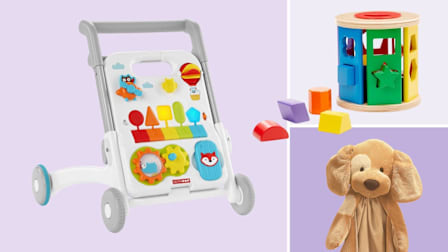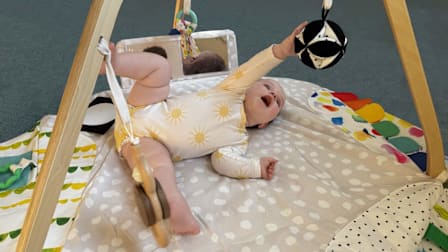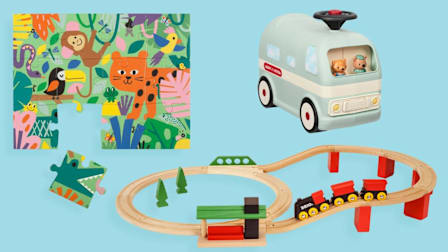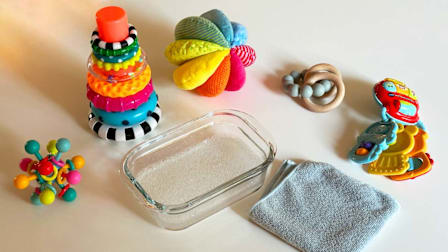These Are the Best Toys for Babies Right Now
9 classic baby toys that will captivate your favorite little one
When you shop through retailer links on our site, we may earn affiliate commissions. 100% of the fees we collect are used to support our nonprofit mission. Learn more.
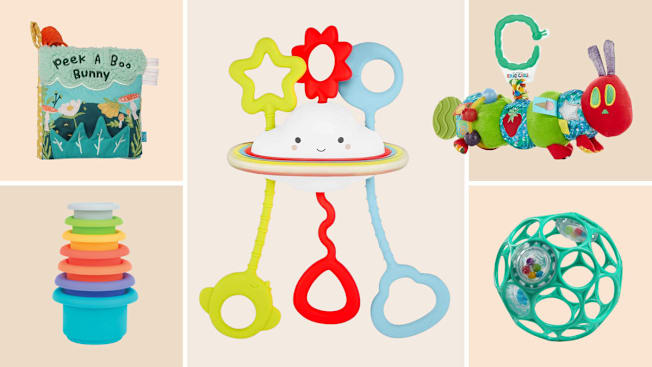
Even as a veteran mom, sometimes I find myself staring at my baby after the cuddles and feeds and diaper changes are over, wondering . . . what do we do now? Luckily, there’s a wide diversity of fun baby toys, whether your baby is brand new or closing in on the big first birthday. The work of childhood is play, and so much of a child’s physical, emotional, and cognitive development happens during seemingly everyday moments of gnawing on a teether toy or shaking a rattle to hear its tinkle.
How to Choose Toys for Babies
Don’t think you need a full playroom with every toy under the sun. “There is no ‘right’ number of toys,” says Courtney Peebles, founder of Solobo Toys, a Montessori-inspired toy company. Babies have that magical and mysterious quality of finding everything fascinating—for your newborn, staring at your cool living room lamp or the dog might be just as enthralling as an actual toy.
Instead, focus on the quality of the toys and what stimulation they provide. “Babies and young children experience rapid brain growth and development in the first years of life, so choosing toys that stimulate the brain and promote problem solving is essential,” says Mary Carol Burkhardt, MD, associate professor of pediatrics, division of general and community pediatrics, director of primary care at Cincinnati Children’s in Ohio.
“Babies learn even more when that play is paired with the trusted people in that child’s life,” she says, so worry less about the type of toy you are choosing and more about how much you are engaging with your baby.
Here are nine essential baby toy categories parents (or nonparents searching for a gift) can turn to if they’re unsure where to start.
Play Gyms and Activity Mats
The best toys for newborns don’t have to be complicated. They are “experiencing everything for the first time, so they really don’t need a bunch of fancy toys to get them started,” Peebles says. Consider a play gym or activity mat if you’re looking for one toy to focus on in those early months—that will also give your arms (and brain) a baby break. (See more baby play gyms CR editors’ babies tested and loved.)
Our Pick
Lovevery The Play Gym
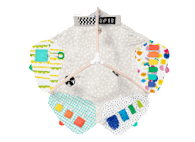
Babies under 6 months can easily become overstimulated, and this play gym takes that into consideration, giving parents the ability to hide or reveal each play zone on the mat. It’s also easy to assemble, machine-washable, and made with organic materials and nontoxic finishes. Bonus: It can grow with babies by turning into a play fort.
High-Contrast Toys
From birth to about 4 months, babies can see objects or people only if they’re about 8 to 10 inches away. Choosing objects with high-contrast colors can help their brain development and give those peepers something interesting to look at—other than you.
“Babies are drawn to high-contrast objects such as black and white images. Faces are also really great,” says Burkhardt.
Our Pick
Etta Loves Reversible Sensory Hanging Squares
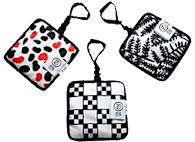
These high-contrast soft squares can be attached to almost anything, such as a stroller bar or play gym, for additional engagement and fascination.
Rachel Coley, a pediatric occupational therapist and Lovevery child development expert based in North Carolina, says to prioritize toys that can be played with in new ways as your child grows. “Open-ended toys like blocks are those that can be used in many ways and easily combined for even more variety.”
Rattles and Sensory Toys
If you watch closely, you can see the moment a baby discovers the concept of cause and effect with a toy that makes a sound when shaken or tugged. “At 6 months, babies are really exploring with their hands and mouths,” says Lizzie Assa, MsED, founder of The Workspace for Children. “Things like rattles and balls with different textures will support their development.” Watching babies find joy in an action they take themselves feels almost like magic.
Our Pick
Skip Hop Silver Lining Pull and Play Sensory Toy
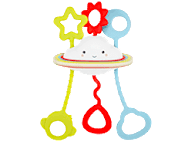
This super-cute sensory toy for babies encourages little hands to practice gripping and squeezing. Each mouthable silicone tab on the toy has a different texture to explore, and the tabs each produce different sounds when pulled.
Grasping Toys
Until about 6 months of age, babies have a surprisingly strong grasping reflex that is involuntary at first but can become purposeful when they focus on an object they want to get their chubby little mitts on. You can help them practice this fine motor skill with toys that are easy to grasp, clutch, and hold.
Our Pick
Bright Starts OBall
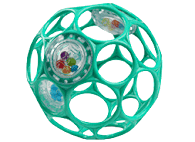
Don’t let the simplicity of this toy fool you. It can quickly become a favorite, first for grasping and gnawing on, and later for rolling or kicking to crawl or chase after. It wipes clean easily and is compact enough that it’s easy to toss into a diaper bag for on-the-go play.
Teethers
Teething typically starts around 3 months of age and lasts until your child is about 3 years old, when the last of the molars come in. As one can imagine, bone piercing through soft gums can cause irritability, soreness, and lots and lots of drool.
Our Pick
Nuby Super Soft Silicone Teether
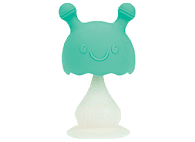
While this can’t help with the drool (sorry), this silicone teether will bring relief to those tender gums. The subtle textures on the toy make the chew all the more satisfying, and the easy-to-grip shape can help your baby’s grasp development. Bonus: It can also suction to a high chair table or stroller tray, which gives the baby a satisfying wobble toy to play with.
Board Books or Soft Books
There’s no age that’s too young to start reading to children, and a soft book offers an additional sensory experience. Reading helps build bonds, establish routines (bath, book, bed), and encourage language development.
Our Pick
Manhattan Toy Fairytale Peek-a-Boo Book
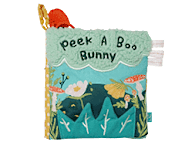
There’s so much tactile goodness packed into this soft package. It has crinkle pages, fabric peek-a-boo flaps, a tethered bunny that squeaks, and all sorts of textures, ribbons, and pom-poms that will pique your baby’s curiosity.
Bath Toys
There’s a parent-tested saying about what to do with a cranky baby: “Just add water.” Most times, it works like magic. Bath time can serve as a relaxing routine that’s part of bedtime or as a fun, supervised play environment during the day.
Our Pick
Nuby Stacking Soft Silicone Cups
Bath toys are notorious for growing mold in nooks and crannies, so instead of squeezy toys that may inevitably become sludge-filled, try these stacking cups. They help develop baby’s hand-eye coordination and fine motor skills and have endless play possibilities, such as “boats” that float, a tall tower, or something baby can gather water in and watch as it rains out of the different-shaped holes.
Tummy Time Toys
Some babies hate tummy time—when you think about it, it’s easy to understand why. It’s probably exhausting to develop and strengthen those neck and shoulder muscles. But as with all things we hate, there are ways to make it more fun.
Our Pick
Sassy See Me Floor Mirror
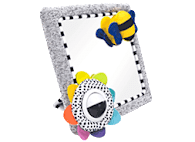
“Unbreakable mirrors are my favorite toy, as babies begin to recognize their reflection,” Assa says. “There’s nothing cuter.” While the baby won’t know that the adorable face staring back at them is their own (young children typically don’t recognize their reflections until about 15 to 18 months), they will be endlessly fascinated by what they see. This baby-safe mirror has an easel back, making it simple to prop in front of a baby as they do tummy time, and there’s a rolly trackball and sweet little bee to touch and examine.
On-the-Go Attachable Toys
One of the (many) wonderful things about babies is their portability. So whether someone’s feeling a little stir-crazy (not to name names) or needs to run a bunch of adult errands with a baby in tow, attachable stroller toys can be a lifesaver.
Our Pick
Eric Carle ‘Very Hungry Caterpillar’ Activity Toy
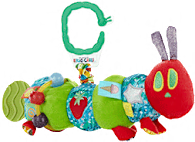
Attachable toys are exceptionally convenient for parents, and you can tell they are attachable because they have a loop somewhere on the toy that multipurpose baby ring links can hook on to. You can add these to a variety of places, such as hanging this caterpillar friend from a low kitchen cabinet for floor play while you are cooking, on a stroller bar, or elsewhere. I’ve even gently attached these links and toys like the caterpillar right onto a baby’s shirt or pant leg pocket or loop during supervised play so that they aren’t constantly losing their toy when they are too little to keep hold of it. This caterpillar in particular is fun to hold while you read the baby the corresponding classic book, or on its own, as babies love to learn cause and effect by making it jingle, crinkle, and rattle.
A Note to Parents About Toy Safety
Babies can quickly end up crawling to small items on the ground when playing in a playroom with older kids’ toys with smaller pieces. Keep an eye out for toy safety when you start introducing toys to babies, Burkhardt says. “Make sure toys are age-appropriate. Choking hazards are concerning for infants and toddlers. I would watch out for magnets and water beads, as they can be problematic if swallowed. Watch toys that have strings or long cords as well.” With a few precautions and a lot of caregiver involvement, playing with a baby’s new toys should be almost as precious as their cute little baby faces.


















